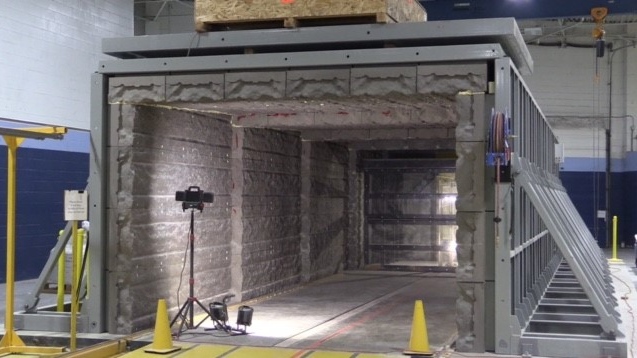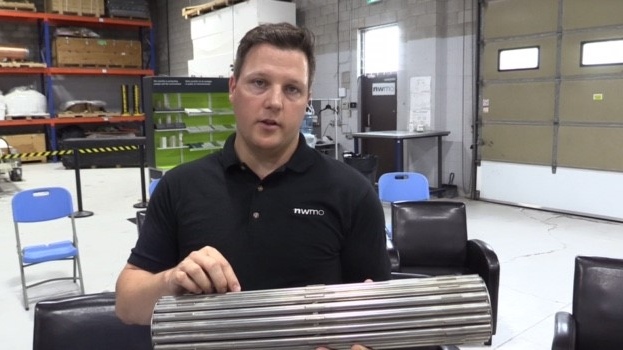Nuclear waste safety case on display at GTA demo centre
Jeff Binns is one of many scientists who has spent the past two decades trying to come up with the safest way to keep Canada’s most radioactive waste safe for the next million years.
“We often use that number, but that means forever,” said Binns, who works for the Nuclear Waste Management Organization (NWMO).
Binns and a team of scientists and researchers have been doing some of that work at NWMO’s Discovery and Demonstration Centre in Oakville.
They’ve spent over a decade designing a copper-lined, carbon steel canister to protect the used nuclear fuel bundles from corrosion, and the bentonite clay boxes that could house each copper lined canister.
Those bentonite clay boxes would then be placed in a series of cavernous underground tunnels, called emplacement rooms, approximately 550 metres underground. Each designed to keep the highly radioactive fuel bundles from interacting with the natural environment.
 An example of a used nuclear fuel emplacement room, where Canada’s used nuclear fuel bundles could be placed in, within copper-lined canisters inside bentonite clay boxes, seen in Oakville on June 25, 2024. (Scott Miller/CTV News London)
An example of a used nuclear fuel emplacement room, where Canada’s used nuclear fuel bundles could be placed in, within copper-lined canisters inside bentonite clay boxes, seen in Oakville on June 25, 2024. (Scott Miller/CTV News London)
“Each level of safety has a very, very low chance of failure in and of itself, and when you stack them on top of each other, it’s an exceedingly low chance of failure. We have an incredible amount of confidence in the safety of the design,” said Binns.
That level of confidence is not shared by some of the potential neighbours of the project near Teeswater or Ignace, where the proposed project could end up.
However, Binns said he would personally be more than happy to live near or even above the project. He’s that confident in the design.
“100 per cent. I would feel completely confident living on top of this DGR (Deep Geological Repository),” said Binns.
 Bentonite clay boxes that could house copper lined canisters, containing Canada’s used nuclear fuel bundles, seen in Oakville on June 25, 2024. (Scott Miller/CTV News London)
Bentonite clay boxes that could house copper lined canisters, containing Canada’s used nuclear fuel bundles, seen in Oakville on June 25, 2024. (Scott Miller/CTV News London)
NWMO plans to choose between building Canada’s first permanent nuclear waste storage facility under farmers’ fields near Teeswater, or under forested land near Ignace, in just a few months time.
“The Nuclear Waste Management Organization believes we’ll be able to pick a site this year. All of this engineering work to develop solutions for containers, transportation, and deep burial, is well underway so we can prove the concepts when we go for licensing approvals,” said NWMO’s Fred Kuntz.
In the meantime, Binns and his fellow researchers will continue to try and perfect something that nuclear nations around the world are attempting to do, but none has yet accomplished. The permanent isolation of radioactive nuclear waste, for eternity.
“In any sort of event, deep underground is a much safer scenario than at the surface where the fuel stands today,” said Binns.
 Jeff Binns, corrosion scientist with the Nuclear Waste Management Organization, holding an example of a used nuclear fuel bundle in Oakville on June 25, 2024. (Scott Miller/CTV News London)
Jeff Binns, corrosion scientist with the Nuclear Waste Management Organization, holding an example of a used nuclear fuel bundle in Oakville on June 25, 2024. (Scott Miller/CTV News London)
CTVNews.ca Top Stories

Calgary woman stranded in Mexico after husband's death during diving trip
A Calgary woman is struggling to return home after her husband died while diving in Mexico, leaving her stranded and facing financial hardship.
Fugitive U.S. rioter seeks asylum in Whistler amid warnings of more to come
An American citizen convicted of participating in the Jan. 6, 2021, riot on Capitol Hill and dodging jail time in Whistler may just be the start of an asylum-seeking rush, according to a prominent legal expert.
Special national Liberal caucus meeting called for next week after regional chairs meet: sources
A special meeting of Prime Minister Justin Trudeau's national Liberal caucus has been called for next Wednesday, sources say.
N.S. community shocked by deaths of father, daughter; suspect was wanted in Toronto shooting
A Nova Scotia community is mourning the loss of two of its members after they were shot and killed in Halifax on New Year's Eve.
Canada pausing applications for parent, grandparent permanent residency sponsorships
Canada will not accept new parent and grandparent permanent residency sponsorship applications until further notice, according to a ministerial directive.
Soldier who blew up Tesla at Trump hotel left note saying blast was to be a 'wakeup call' for the U.S.
A highly decorated Army soldier who fatally shot himself in a Tesla Cybertruck just before it blew up outside the Trump hotel in Las Vegas left notes saying the New Year's Day explosion was a stunt to serve as a “wakeup call” for the country’s ills, investigators said Friday.
Sea and Himalayan salts recalled in Canada: 'Do not use, serve or distribute'
Two brands of sea and Himalayan salt are being recalled in Canada due to pieces of plastic found in the products.
'Inadmissible' foreign nationals to pay more upon return to Canada: CBSA
Foreign nationals who refuse or are unable to pay their own way home after being denied stay in Canada will soon face steeper financial penalties should they ever attempt to return.
'It's about time': Experts in Canada support call for warnings about cancer risk from alcohol
While Canada hasn't mandated cancer warnings for alcoholic beverages, a few experts are supporting a new push in the U.S. to have the labels on the products.


































